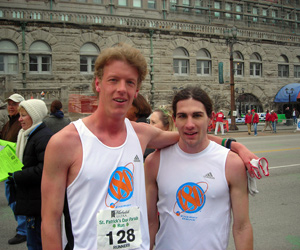We’ve all been there before-textbook cracked open, pen in hand, and all of a sudden our stomach starts to growl. It’s time to take a break, and snacking is the perfect excuse. In fact, many students admit to snacking while studying just because it helps pass the time.
While in Olin library, students often run to Whispers to relieve hunger. Unfortunately, most students head towards the pastry display or the grab-n-go snacks in plastic bags. Scones, yogurt-covered pretzels and chocolate-covered espresso beans don’t really qualify as “healthy” snacks. So, to help you through your study session pangs, I have outlined a list of healthy snack options that you can find at the library or make at home.
If you are just in the mood to munch but already ate a meal, opt for vegetables and fruits. They are full of fiber and low in calories, so they will fill you up quickly without expanding your waistline. I recommend the pre-packaged vegetable platters and fruit salad in the library, as well as any of the whole fruit. Both Bear Mart and the Village Caf‚ also sell small packages of baby carrots, which are convenient to stuff in a backpack and are pretty tasty too. Prepackaged hummus and pita chips are also available on campus, and because of the balance of protein and carbohydrates these foods provide, they can be a great snack. To find out more about the prepackaged food items prepared by Bon App‚tit, check out the dining services website and look at the nutritional information: http://diningservices.wustl.edu.
A great way to take a piece of fruit and make it a bit more filling is to add some peanut butter. Peanut butter is great with bananas or apples, and the added bit of protein and fat can do a lot to fill you up. Cheese is also a good source of protein that complements fruit. However, be aware that the full-fat cheese in Bon App‚tit’s fruit and cheese platters is loaded with calories and fat and may not be the slimming snack you had in mind. Instead, head to Bear Mart or the Village Caf‚ to buy part-skim string cheeses. These usually have only 80 calories and 5 or fewer grams of fat. Pair that kind of string cheese with an apple, and you have yourself a healthy and filling snack.
Whole-grain cereal is also a great option when you have the munchies. Take some of your favorite cereal, put it in a Ziploc bag, and take it with you to the library. You can always buy some milk downstairs to add protein and calcium and to make your snack a bit more filling. Or try adding some almonds, dried cranberries, raisins, walnuts or other dried fruits and berries to cereal and create your own trail mix. Keep in mind that nuts and dried fruits, while healthy, are loaded with calories, but with that said, just a small amount with some fiber-packed cereal could leave you feeling very full.
For more traditional snacks that are fairly portable, granola bars, popcorn, and pretzels are all great options. However, it is important not to overindulge on these snacks, since it is easy to write them off as “healthy” and munch on them nonstop.
To avoid continuous munching, I recommend buying smaller and healthier versions of your favorite treats. When purchasing granola bars, look for bars that stay around 100 calories. When it comes to popcorn, look for the new 100-calorie pop bags with only 3.5 grams of fat in butter and kettle corn flavors. As far as pretzels are concerned, keep in mind that if you buy a bag at the library, each bag has 220 calories-which means you could have two granola bars or two bags of popcorn for just one bag of pretzels. Also, keep in mind that while these snacks are “healthier” options, they do not provide a lot of protein or vitamins and minerals. If you can, you are much better off snacking on the fruits, vegetables, nuts, cheese, and whole-grain cereal as I mentioned above.
As a general rule, avoid items from the pastry display or vending machine. Although food like muffins, scones, and Snickers bars may provide a quick “pick-me-up,” they are very low in nutrients and high in sugar and calories. The initial feeling of energy you get from eating a sugary snack will not last long, and soon you will feel more tired than if you had skipped the snack altogether. If you can’t resist your craving for a muffin, I encourage you to try the lower-fat varieties. These muffins have only 220 calories and 2.5 grams of fat-compared to the 500 calories and close to 20 grams of fat that lurk in their full-fat counterparts.
Surprisingly, the biggest downfall of most studiers isn’t always the food they snack on, but rather the drinks they consume. Because drinks take less oral processing and leave us less satisfied than normal food, we often forget how many calories they can pack. Regular sodas have about 30 grams of sugar and 160 calories in every 8 ounces, but actually coffee drinks are the biggest source of hidden calories. Flavor syrups can add an extra 60 calories, whole milk can add anywhere from 40-60 and whipped cream can add 80. These additions may make coffee tastier, but the additional calories they provide are usually “empty,” which means they are consumed without really filling you up. Opt for sugar-free syrups when you can and pick skim milk instead of regular to reduce the amount of calories in your lattes. Check out www.starbucks.com/retail/nutrition_info.asp to find out how many calories are in traditional coffee drinks.
Good luck on finals, everyone. Study hard, eat right and ace those tests!
 Courtesy of John Aerni
Courtesy of John Aerni Scott Bressler
Scott Bressler Scott Bressler
Scott Bressler